Annotated Bibliography: Diversity in Organisational Behaviour, OGBH201
VerifiedAdded on 2023/01/23
|5
|1306
|31
Annotated Bibliography
AI Summary
This annotated bibliography examines the impact of diversity on organisational behaviour, drawing on five academic journal articles. The analysis covers various aspects, including communication, diversity training, cultural differences, and their effects on team dynamics, conflict resolution, and overall organisational performance. The articles explore the advantages and disadvantages of diversity, the importance of communication openness, and the need for effective diversity management strategies. Key themes include the role of ethnocentric, modernistic, and cosmopolitan communication, the impact of cultural diversity on global virtual teams, and the mediating effects of conflict and communication on workplace trust. The bibliography highlights the importance of understanding diversity as a long-term, multifaceted issue, emphasizing the need for organisations to adapt their policies and practices to meet the evolving demands of a diverse workforce. The research also highlights the importance of mentor programs and the significance of addressing interpersonal and communication issues within the workplace. The bibliography concludes by advocating for a more formal approach to diversity training, emphasizing the need for measurable, specific goals that align with the company's objectives.
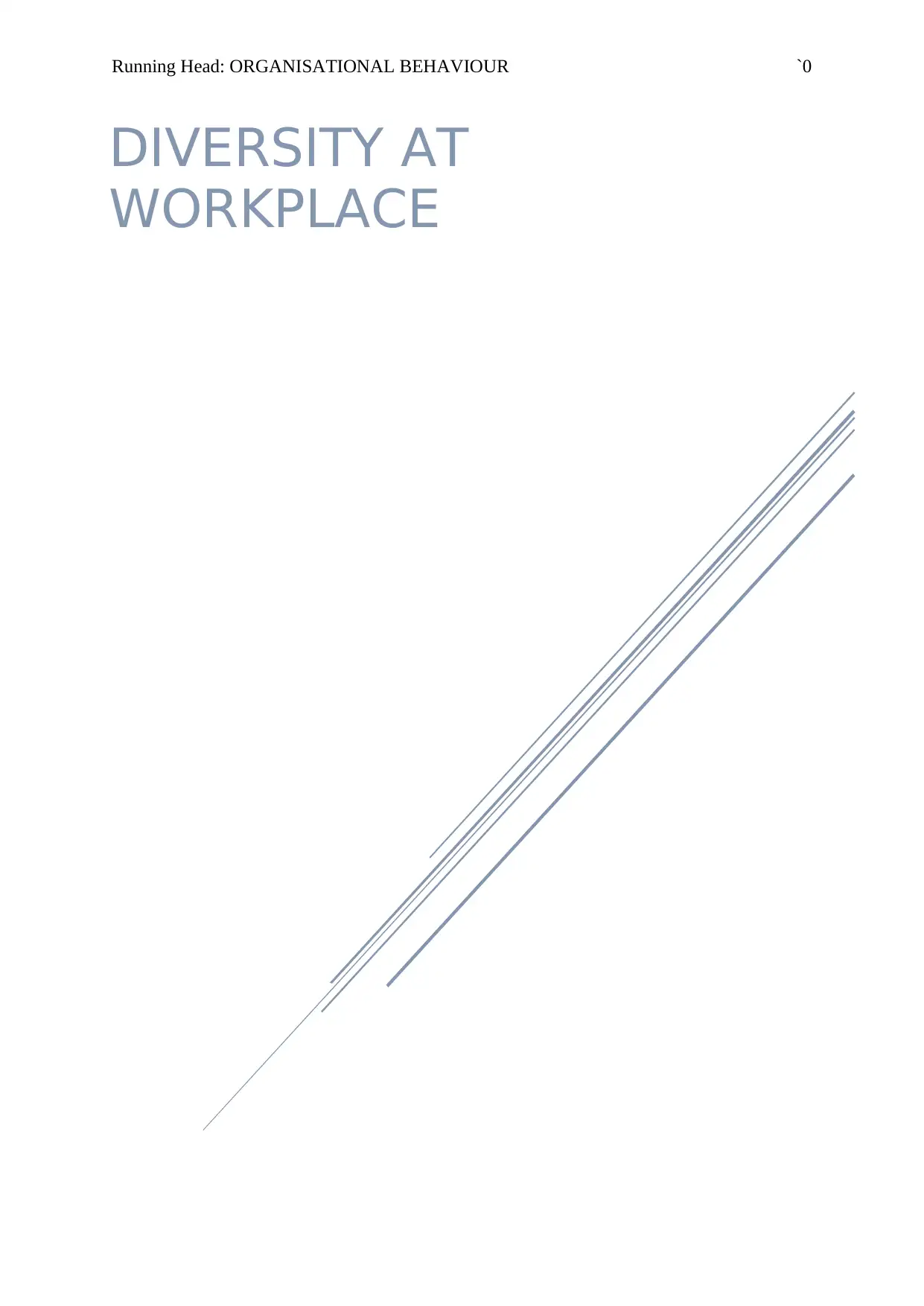
Running Head: ORGANISATIONAL BEHAVIOUR `0
DIVERSITY AT
WORKPLACE
DIVERSITY AT
WORKPLACE
Paraphrase This Document
Need a fresh take? Get an instant paraphrase of this document with our AI Paraphraser
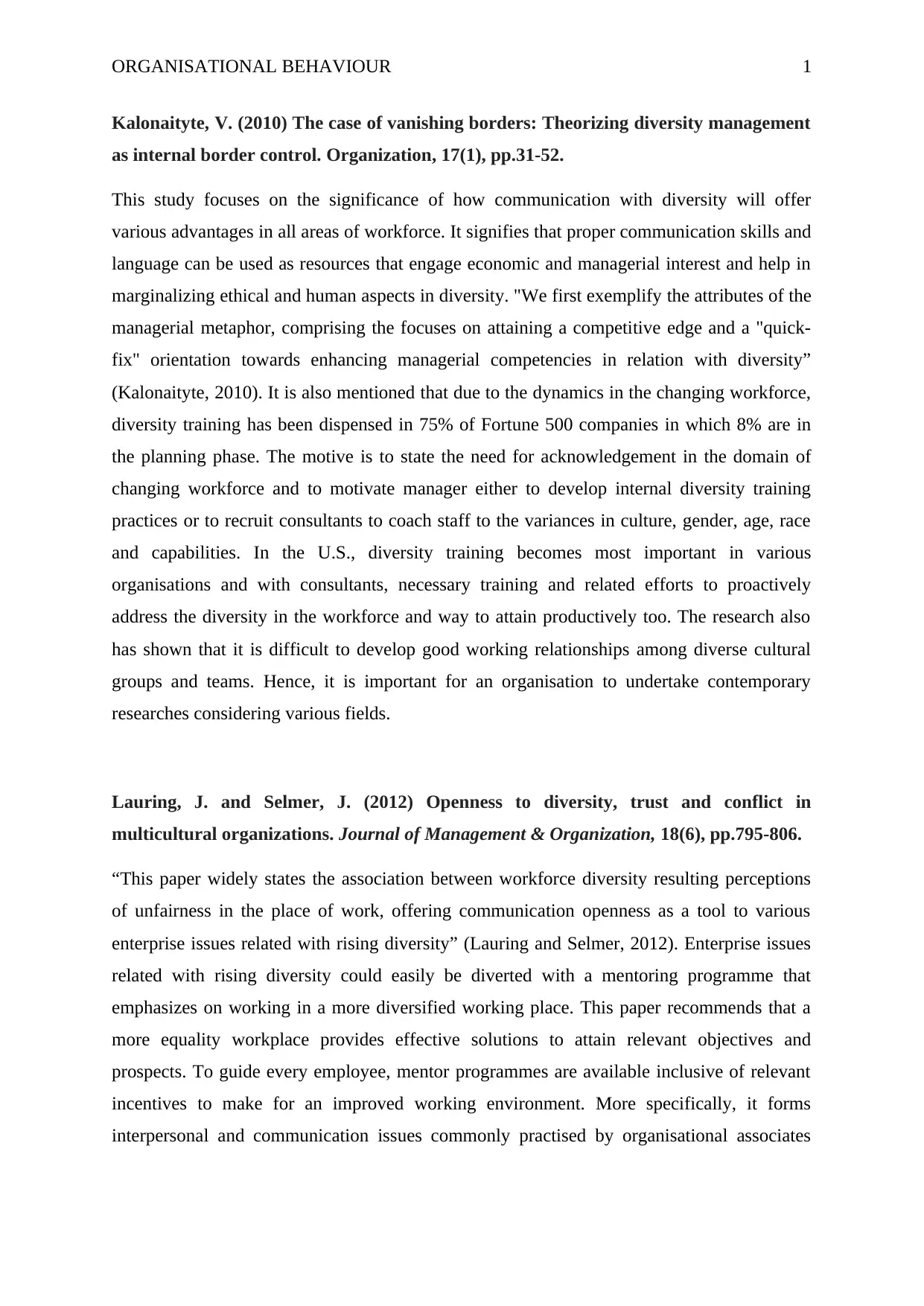
ORGANISATIONAL BEHAVIOUR 1
Kalonaityte, V. (2010) The case of vanishing borders: Theorizing diversity management
as internal border control. Organization, 17(1), pp.31-52.
This study focuses on the significance of how communication with diversity will offer
various advantages in all areas of workforce. It signifies that proper communication skills and
language can be used as resources that engage economic and managerial interest and help in
marginalizing ethical and human aspects in diversity. "We first exemplify the attributes of the
managerial metaphor, comprising the focuses on attaining a competitive edge and a "quick-
fix" orientation towards enhancing managerial competencies in relation with diversity”
(Kalonaityte, 2010). It is also mentioned that due to the dynamics in the changing workforce,
diversity training has been dispensed in 75% of Fortune 500 companies in which 8% are in
the planning phase. The motive is to state the need for acknowledgement in the domain of
changing workforce and to motivate manager either to develop internal diversity training
practices or to recruit consultants to coach staff to the variances in culture, gender, age, race
and capabilities. In the U.S., diversity training becomes most important in various
organisations and with consultants, necessary training and related efforts to proactively
address the diversity in the workforce and way to attain productively too. The research also
has shown that it is difficult to develop good working relationships among diverse cultural
groups and teams. Hence, it is important for an organisation to undertake contemporary
researches considering various fields.
Lauring, J. and Selmer, J. (2012) Openness to diversity, trust and conflict in
multicultural organizations. Journal of Management & Organization, 18(6), pp.795-806.
“This paper widely states the association between workforce diversity resulting perceptions
of unfairness in the place of work, offering communication openness as a tool to various
enterprise issues related with rising diversity” (Lauring and Selmer, 2012). Enterprise issues
related with rising diversity could easily be diverted with a mentoring programme that
emphasizes on working in a more diversified working place. This paper recommends that a
more equality workplace provides effective solutions to attain relevant objectives and
prospects. To guide every employee, mentor programmes are available inclusive of relevant
incentives to make for an improved working environment. More specifically, it forms
interpersonal and communication issues commonly practised by organisational associates
Kalonaityte, V. (2010) The case of vanishing borders: Theorizing diversity management
as internal border control. Organization, 17(1), pp.31-52.
This study focuses on the significance of how communication with diversity will offer
various advantages in all areas of workforce. It signifies that proper communication skills and
language can be used as resources that engage economic and managerial interest and help in
marginalizing ethical and human aspects in diversity. "We first exemplify the attributes of the
managerial metaphor, comprising the focuses on attaining a competitive edge and a "quick-
fix" orientation towards enhancing managerial competencies in relation with diversity”
(Kalonaityte, 2010). It is also mentioned that due to the dynamics in the changing workforce,
diversity training has been dispensed in 75% of Fortune 500 companies in which 8% are in
the planning phase. The motive is to state the need for acknowledgement in the domain of
changing workforce and to motivate manager either to develop internal diversity training
practices or to recruit consultants to coach staff to the variances in culture, gender, age, race
and capabilities. In the U.S., diversity training becomes most important in various
organisations and with consultants, necessary training and related efforts to proactively
address the diversity in the workforce and way to attain productively too. The research also
has shown that it is difficult to develop good working relationships among diverse cultural
groups and teams. Hence, it is important for an organisation to undertake contemporary
researches considering various fields.
Lauring, J. and Selmer, J. (2012) Openness to diversity, trust and conflict in
multicultural organizations. Journal of Management & Organization, 18(6), pp.795-806.
“This paper widely states the association between workforce diversity resulting perceptions
of unfairness in the place of work, offering communication openness as a tool to various
enterprise issues related with rising diversity” (Lauring and Selmer, 2012). Enterprise issues
related with rising diversity could easily be diverted with a mentoring programme that
emphasizes on working in a more diversified working place. This paper recommends that a
more equality workplace provides effective solutions to attain relevant objectives and
prospects. To guide every employee, mentor programmes are available inclusive of relevant
incentives to make for an improved working environment. More specifically, it forms
interpersonal and communication issues commonly practised by organisational associates
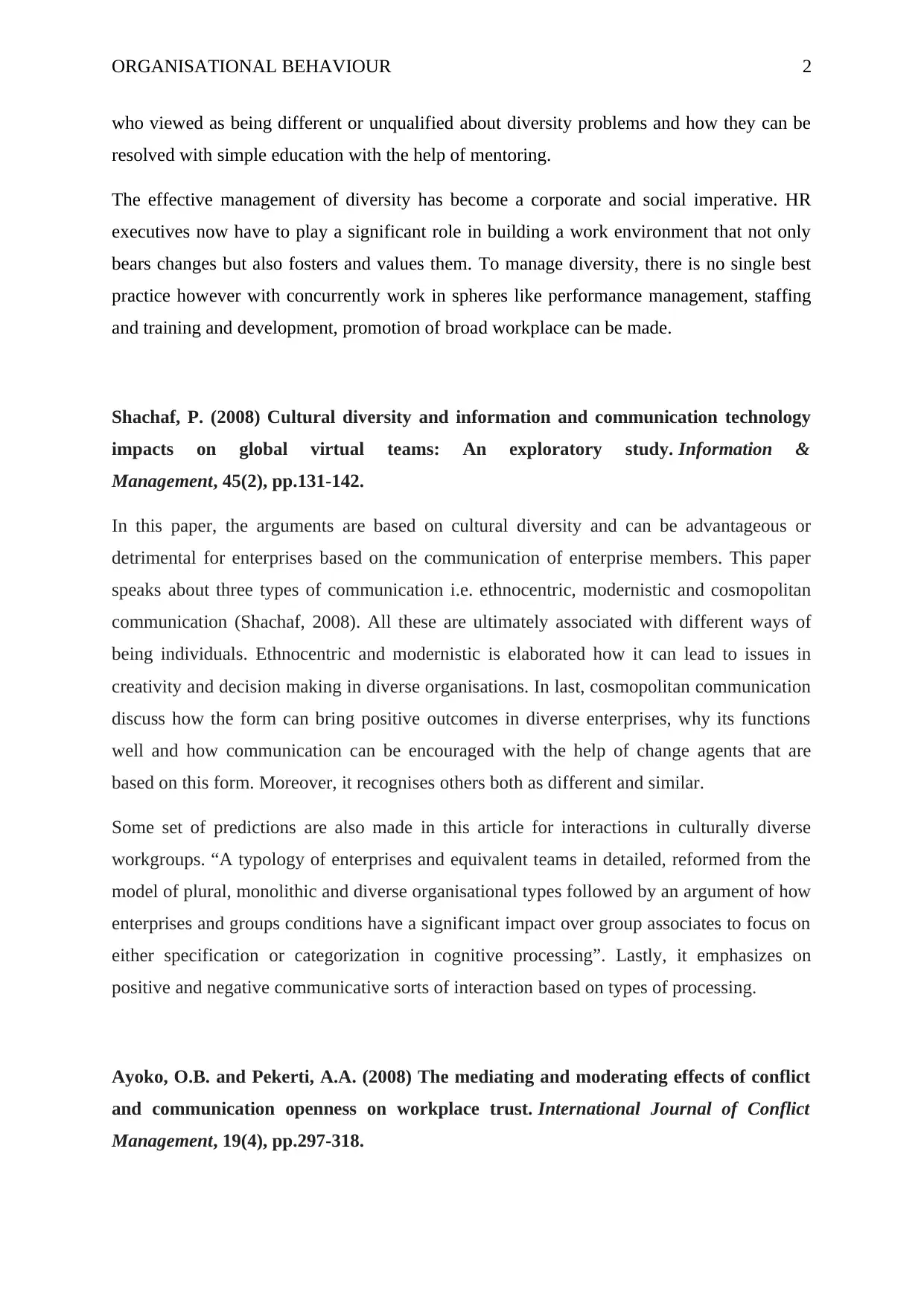
ORGANISATIONAL BEHAVIOUR 2
who viewed as being different or unqualified about diversity problems and how they can be
resolved with simple education with the help of mentoring.
The effective management of diversity has become a corporate and social imperative. HR
executives now have to play a significant role in building a work environment that not only
bears changes but also fosters and values them. To manage diversity, there is no single best
practice however with concurrently work in spheres like performance management, staffing
and training and development, promotion of broad workplace can be made.
Shachaf, P. (2008) Cultural diversity and information and communication technology
impacts on global virtual teams: An exploratory study. Information &
Management, 45(2), pp.131-142.
In this paper, the arguments are based on cultural diversity and can be advantageous or
detrimental for enterprises based on the communication of enterprise members. This paper
speaks about three types of communication i.e. ethnocentric, modernistic and cosmopolitan
communication (Shachaf, 2008). All these are ultimately associated with different ways of
being individuals. Ethnocentric and modernistic is elaborated how it can lead to issues in
creativity and decision making in diverse organisations. In last, cosmopolitan communication
discuss how the form can bring positive outcomes in diverse enterprises, why its functions
well and how communication can be encouraged with the help of change agents that are
based on this form. Moreover, it recognises others both as different and similar.
Some set of predictions are also made in this article for interactions in culturally diverse
workgroups. “A typology of enterprises and equivalent teams in detailed, reformed from the
model of plural, monolithic and diverse organisational types followed by an argument of how
enterprises and groups conditions have a significant impact over group associates to focus on
either specification or categorization in cognitive processing”. Lastly, it emphasizes on
positive and negative communicative sorts of interaction based on types of processing.
Ayoko, O.B. and Pekerti, A.A. (2008) The mediating and moderating effects of conflict
and communication openness on workplace trust. International Journal of Conflict
Management, 19(4), pp.297-318.
who viewed as being different or unqualified about diversity problems and how they can be
resolved with simple education with the help of mentoring.
The effective management of diversity has become a corporate and social imperative. HR
executives now have to play a significant role in building a work environment that not only
bears changes but also fosters and values them. To manage diversity, there is no single best
practice however with concurrently work in spheres like performance management, staffing
and training and development, promotion of broad workplace can be made.
Shachaf, P. (2008) Cultural diversity and information and communication technology
impacts on global virtual teams: An exploratory study. Information &
Management, 45(2), pp.131-142.
In this paper, the arguments are based on cultural diversity and can be advantageous or
detrimental for enterprises based on the communication of enterprise members. This paper
speaks about three types of communication i.e. ethnocentric, modernistic and cosmopolitan
communication (Shachaf, 2008). All these are ultimately associated with different ways of
being individuals. Ethnocentric and modernistic is elaborated how it can lead to issues in
creativity and decision making in diverse organisations. In last, cosmopolitan communication
discuss how the form can bring positive outcomes in diverse enterprises, why its functions
well and how communication can be encouraged with the help of change agents that are
based on this form. Moreover, it recognises others both as different and similar.
Some set of predictions are also made in this article for interactions in culturally diverse
workgroups. “A typology of enterprises and equivalent teams in detailed, reformed from the
model of plural, monolithic and diverse organisational types followed by an argument of how
enterprises and groups conditions have a significant impact over group associates to focus on
either specification or categorization in cognitive processing”. Lastly, it emphasizes on
positive and negative communicative sorts of interaction based on types of processing.
Ayoko, O.B. and Pekerti, A.A. (2008) The mediating and moderating effects of conflict
and communication openness on workplace trust. International Journal of Conflict
Management, 19(4), pp.297-318.
⊘ This is a preview!⊘
Do you want full access?
Subscribe today to unlock all pages.

Trusted by 1+ million students worldwide
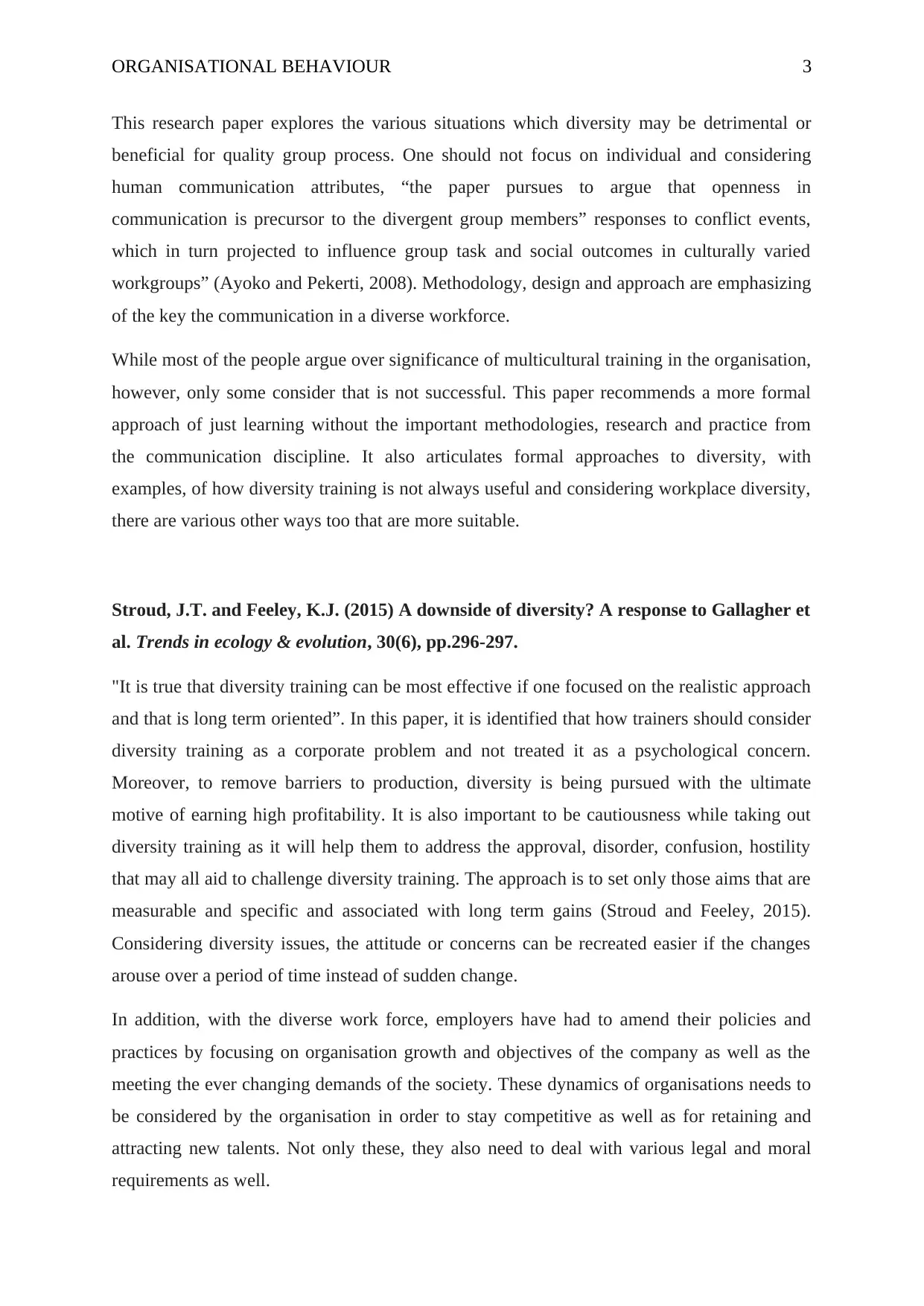
ORGANISATIONAL BEHAVIOUR 3
This research paper explores the various situations which diversity may be detrimental or
beneficial for quality group process. One should not focus on individual and considering
human communication attributes, “the paper pursues to argue that openness in
communication is precursor to the divergent group members” responses to conflict events,
which in turn projected to influence group task and social outcomes in culturally varied
workgroups” (Ayoko and Pekerti, 2008). Methodology, design and approach are emphasizing
of the key the communication in a diverse workforce.
While most of the people argue over significance of multicultural training in the organisation,
however, only some consider that is not successful. This paper recommends a more formal
approach of just learning without the important methodologies, research and practice from
the communication discipline. It also articulates formal approaches to diversity, with
examples, of how diversity training is not always useful and considering workplace diversity,
there are various other ways too that are more suitable.
Stroud, J.T. and Feeley, K.J. (2015) A downside of diversity? A response to Gallagher et
al. Trends in ecology & evolution, 30(6), pp.296-297.
"It is true that diversity training can be most effective if one focused on the realistic approach
and that is long term oriented”. In this paper, it is identified that how trainers should consider
diversity training as a corporate problem and not treated it as a psychological concern.
Moreover, to remove barriers to production, diversity is being pursued with the ultimate
motive of earning high profitability. It is also important to be cautiousness while taking out
diversity training as it will help them to address the approval, disorder, confusion, hostility
that may all aid to challenge diversity training. The approach is to set only those aims that are
measurable and specific and associated with long term gains (Stroud and Feeley, 2015).
Considering diversity issues, the attitude or concerns can be recreated easier if the changes
arouse over a period of time instead of sudden change.
In addition, with the diverse work force, employers have had to amend their policies and
practices by focusing on organisation growth and objectives of the company as well as the
meeting the ever changing demands of the society. These dynamics of organisations needs to
be considered by the organisation in order to stay competitive as well as for retaining and
attracting new talents. Not only these, they also need to deal with various legal and moral
requirements as well.
This research paper explores the various situations which diversity may be detrimental or
beneficial for quality group process. One should not focus on individual and considering
human communication attributes, “the paper pursues to argue that openness in
communication is precursor to the divergent group members” responses to conflict events,
which in turn projected to influence group task and social outcomes in culturally varied
workgroups” (Ayoko and Pekerti, 2008). Methodology, design and approach are emphasizing
of the key the communication in a diverse workforce.
While most of the people argue over significance of multicultural training in the organisation,
however, only some consider that is not successful. This paper recommends a more formal
approach of just learning without the important methodologies, research and practice from
the communication discipline. It also articulates formal approaches to diversity, with
examples, of how diversity training is not always useful and considering workplace diversity,
there are various other ways too that are more suitable.
Stroud, J.T. and Feeley, K.J. (2015) A downside of diversity? A response to Gallagher et
al. Trends in ecology & evolution, 30(6), pp.296-297.
"It is true that diversity training can be most effective if one focused on the realistic approach
and that is long term oriented”. In this paper, it is identified that how trainers should consider
diversity training as a corporate problem and not treated it as a psychological concern.
Moreover, to remove barriers to production, diversity is being pursued with the ultimate
motive of earning high profitability. It is also important to be cautiousness while taking out
diversity training as it will help them to address the approval, disorder, confusion, hostility
that may all aid to challenge diversity training. The approach is to set only those aims that are
measurable and specific and associated with long term gains (Stroud and Feeley, 2015).
Considering diversity issues, the attitude or concerns can be recreated easier if the changes
arouse over a period of time instead of sudden change.
In addition, with the diverse work force, employers have had to amend their policies and
practices by focusing on organisation growth and objectives of the company as well as the
meeting the ever changing demands of the society. These dynamics of organisations needs to
be considered by the organisation in order to stay competitive as well as for retaining and
attracting new talents. Not only these, they also need to deal with various legal and moral
requirements as well.
Paraphrase This Document
Need a fresh take? Get an instant paraphrase of this document with our AI Paraphraser
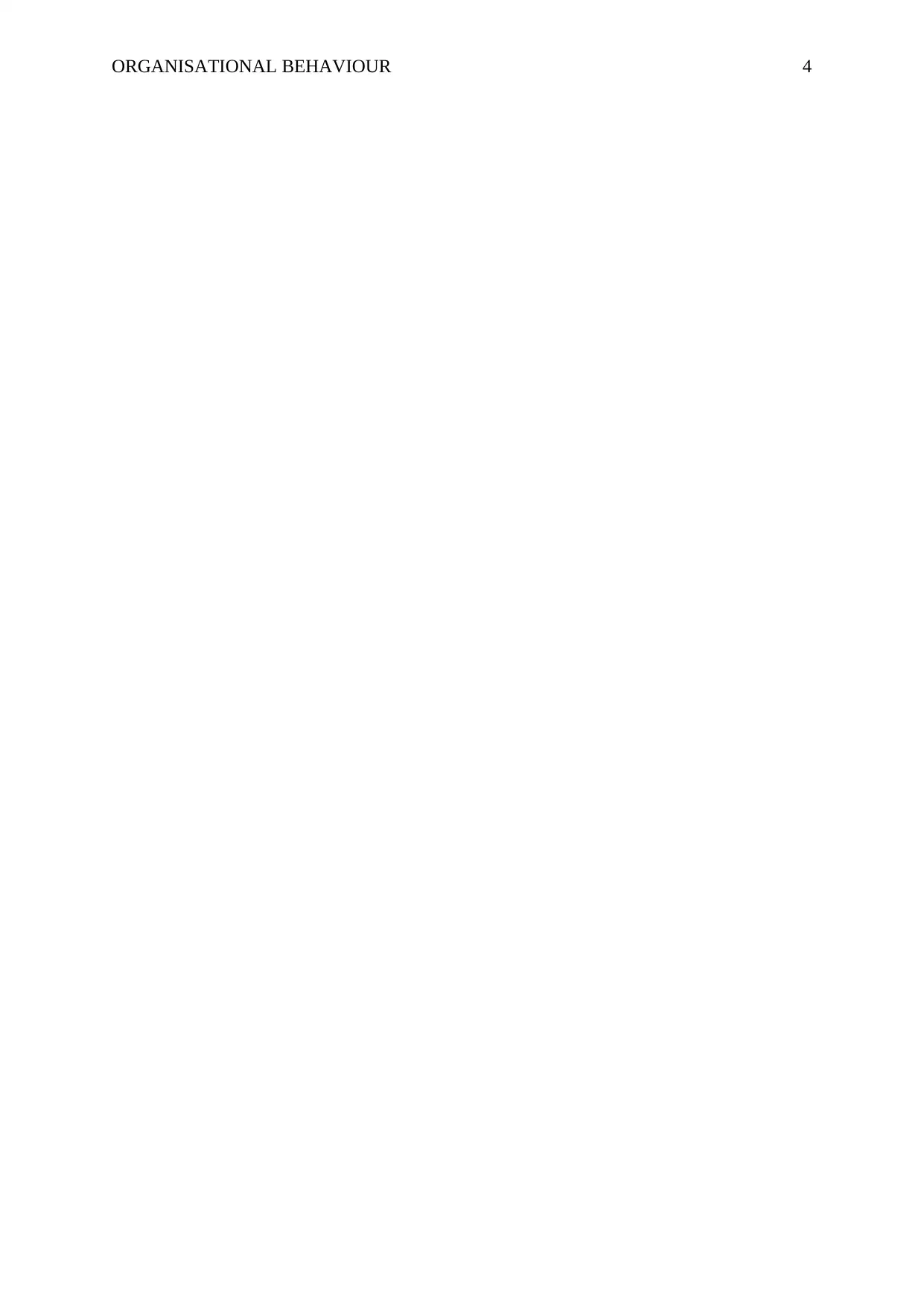
ORGANISATIONAL BEHAVIOUR 4
1 out of 5
Related Documents
Your All-in-One AI-Powered Toolkit for Academic Success.
+13062052269
info@desklib.com
Available 24*7 on WhatsApp / Email
![[object Object]](/_next/static/media/star-bottom.7253800d.svg)
Unlock your academic potential
Copyright © 2020–2025 A2Z Services. All Rights Reserved. Developed and managed by ZUCOL.





